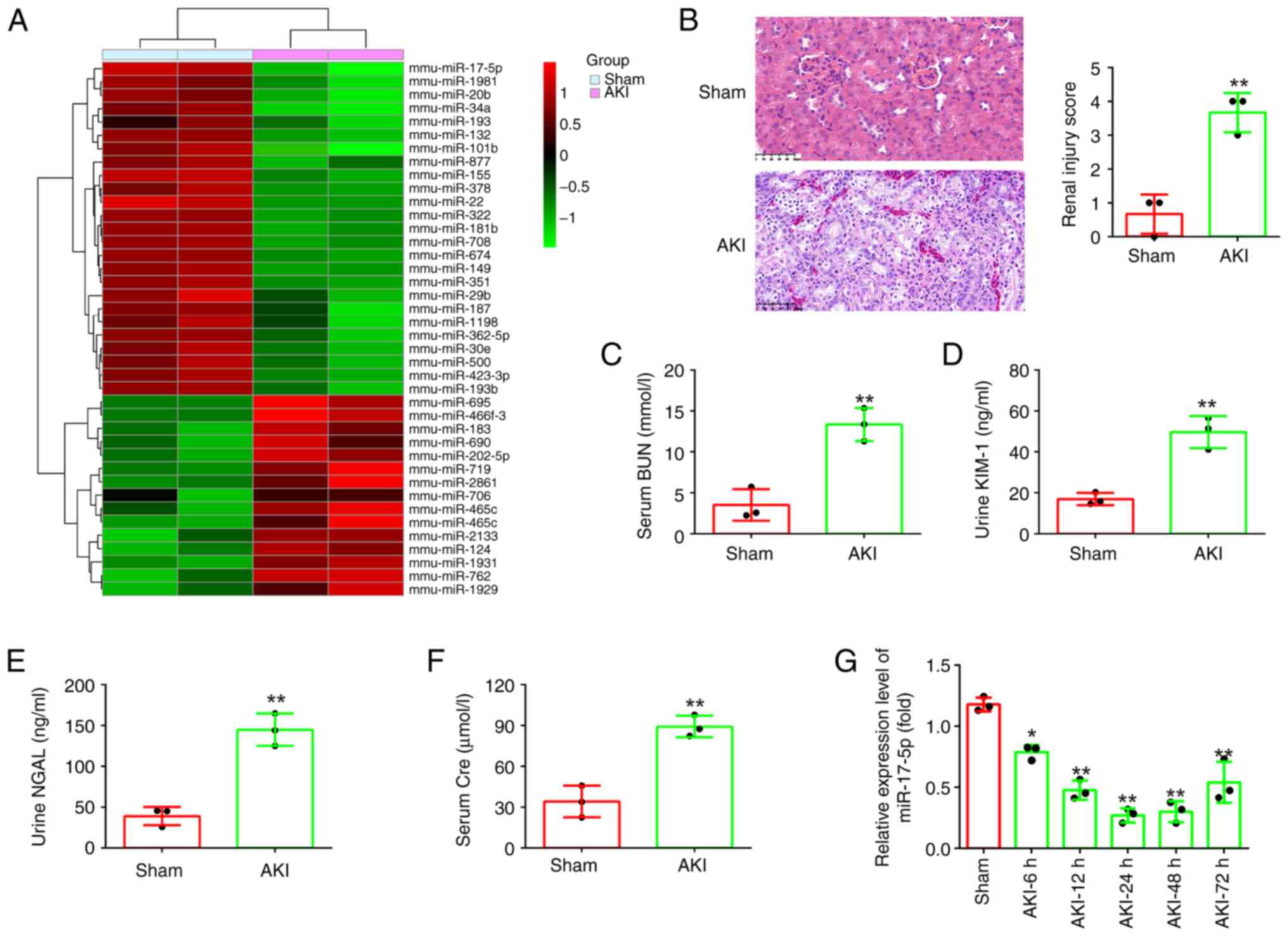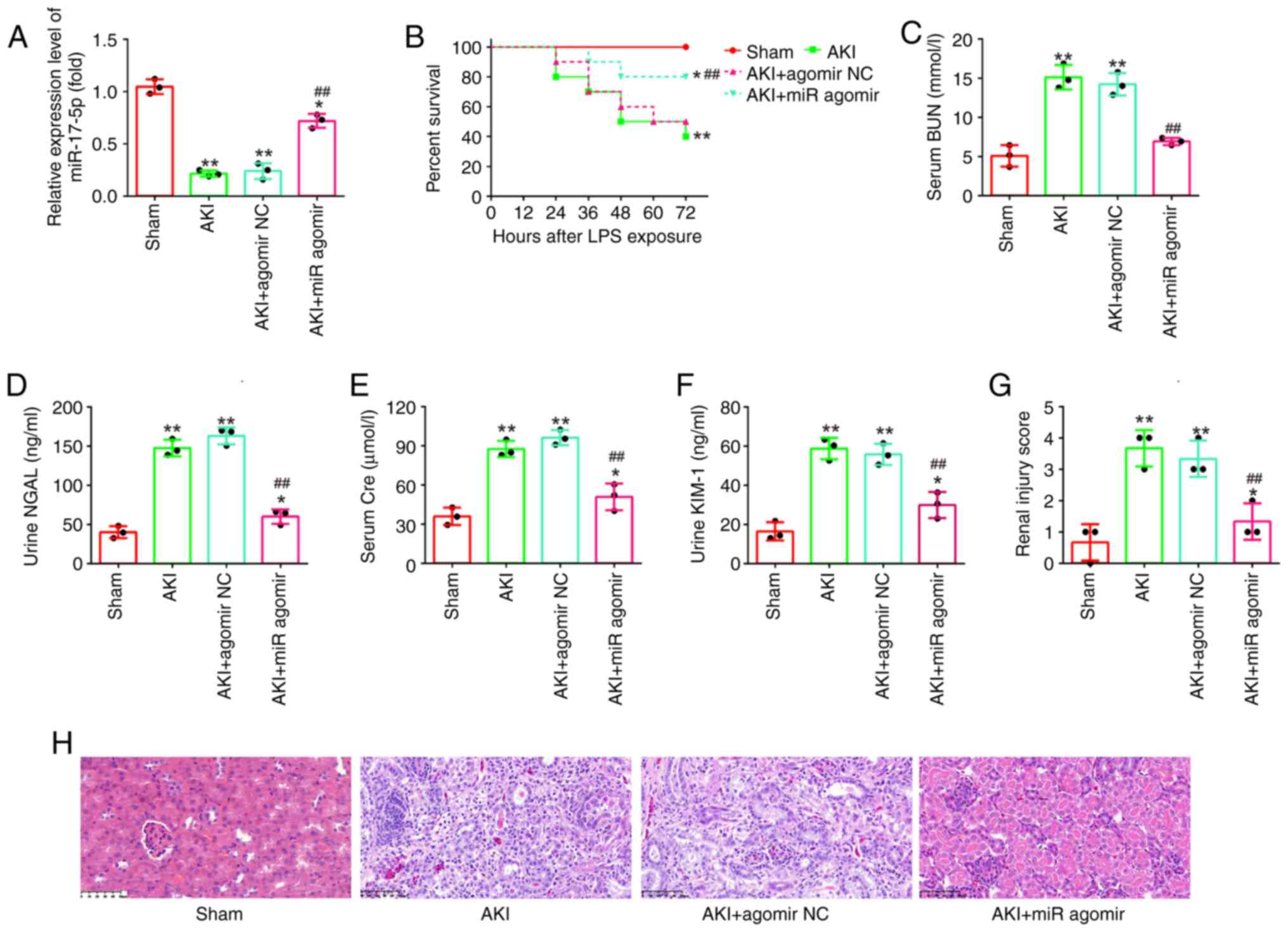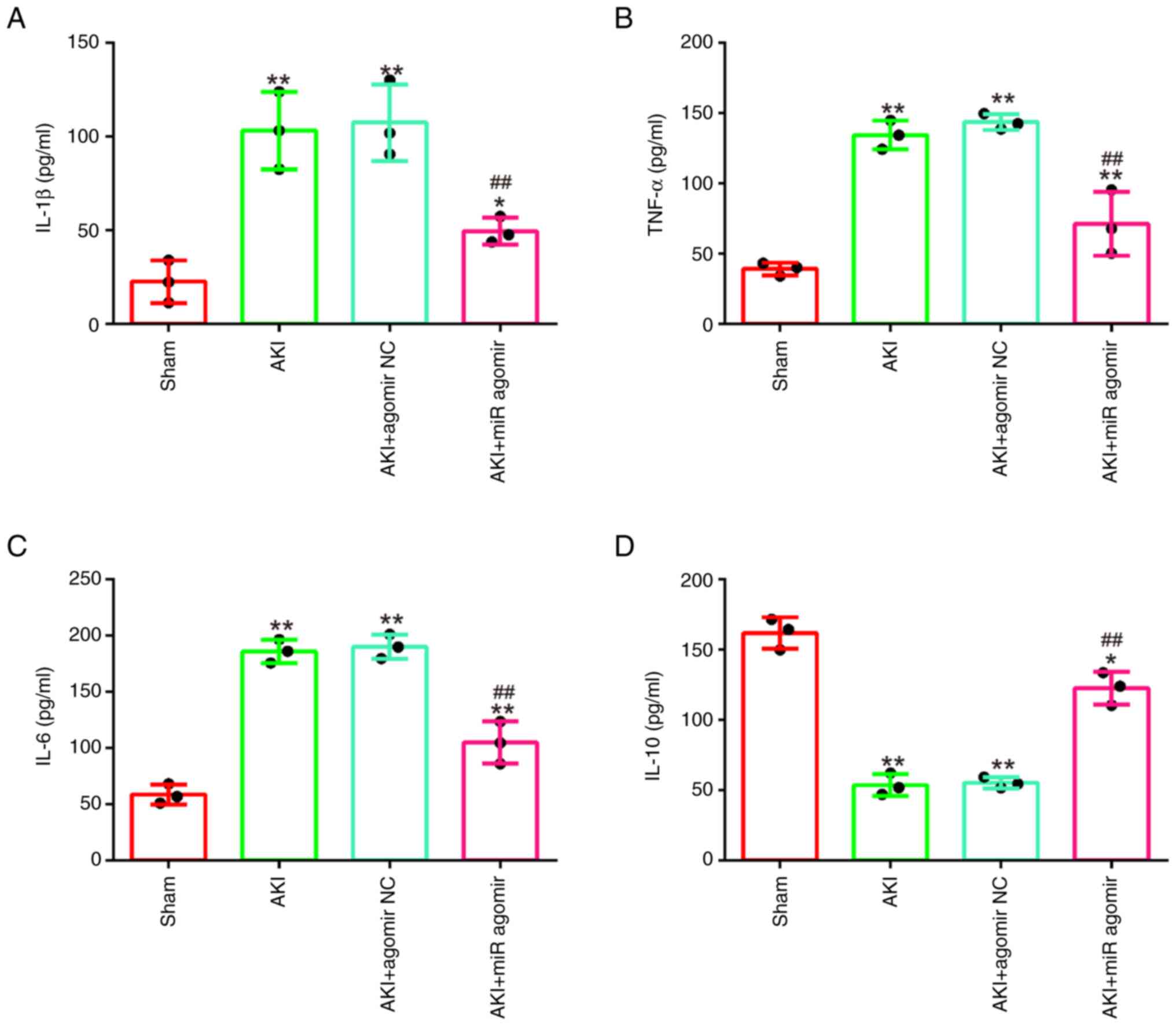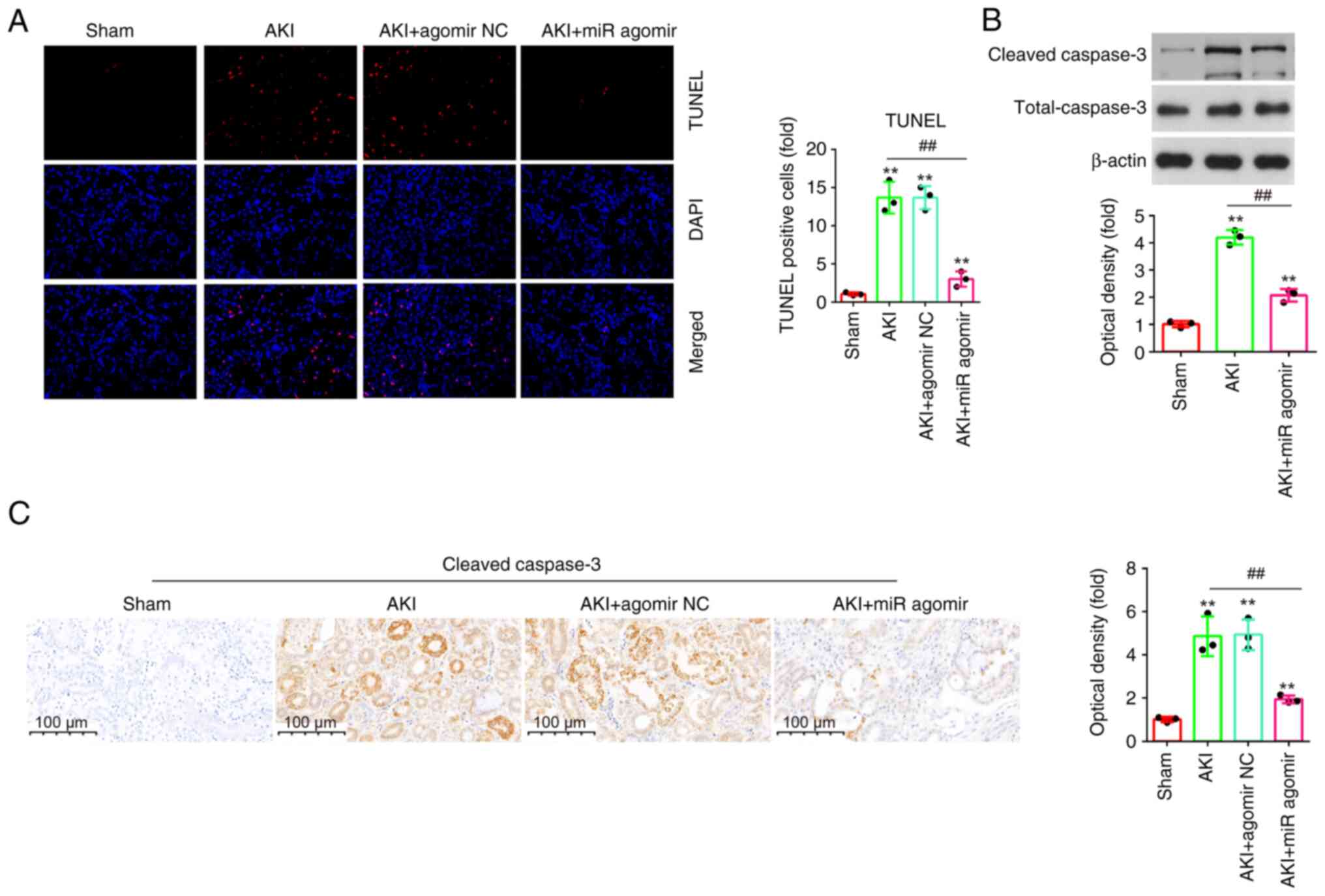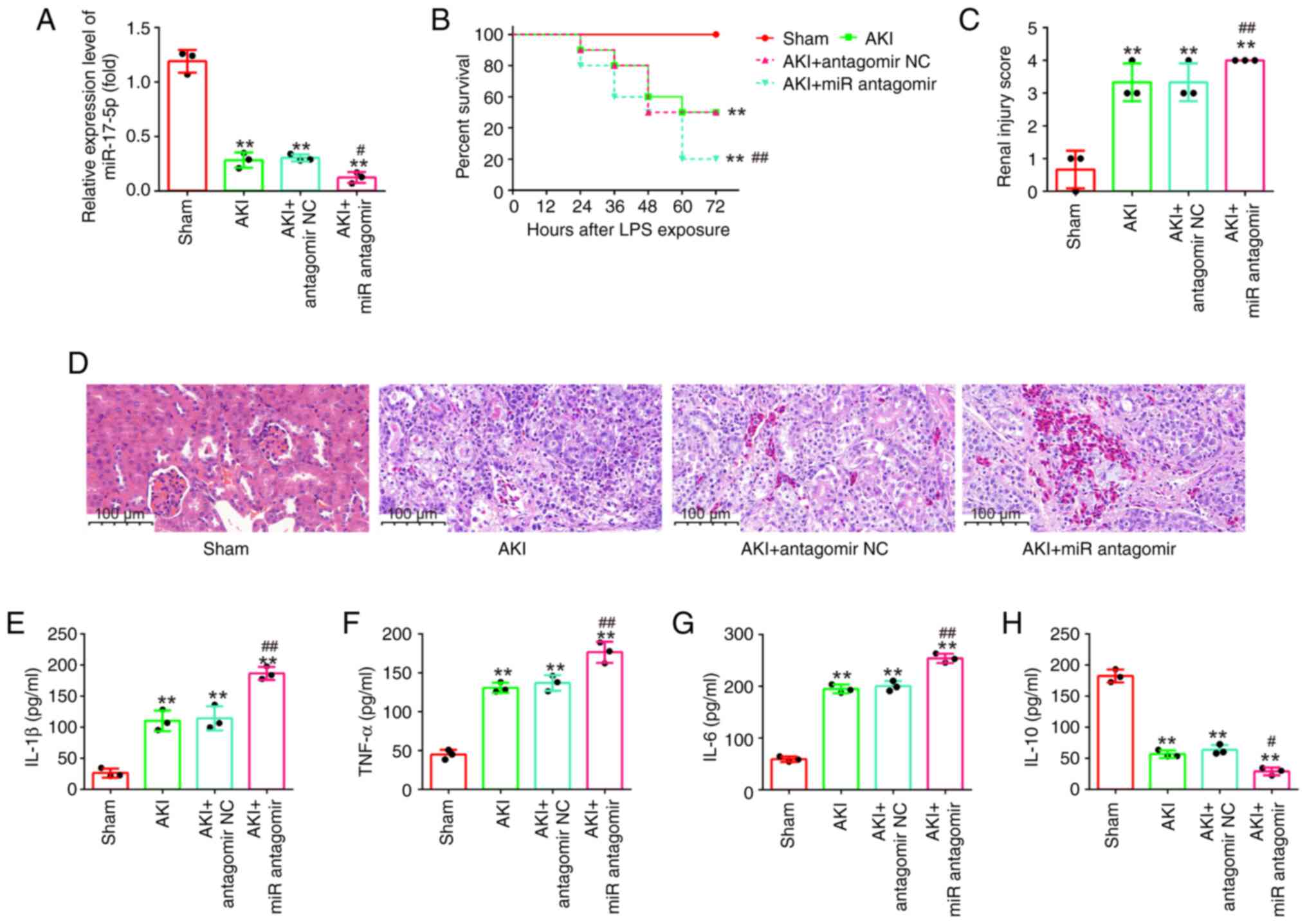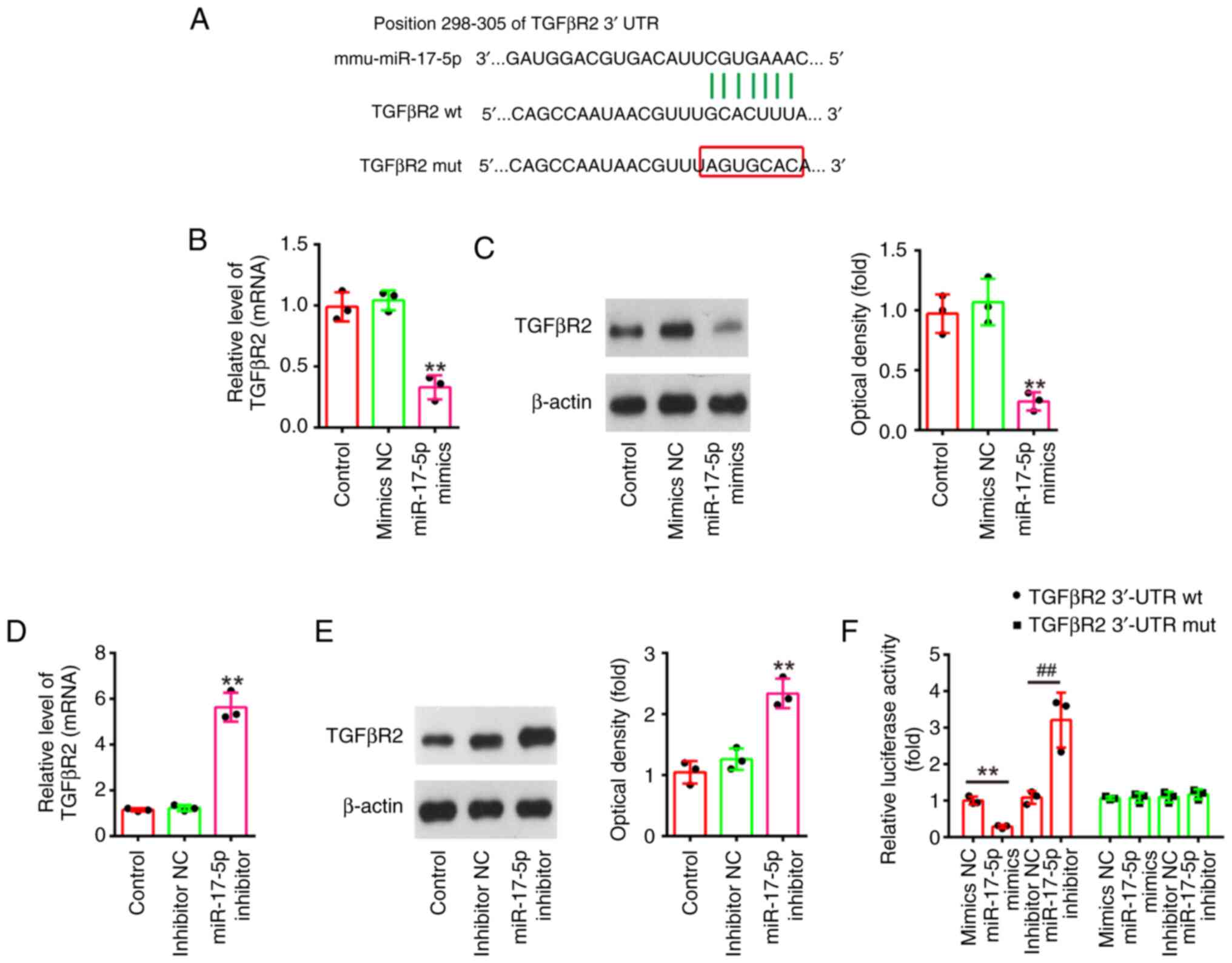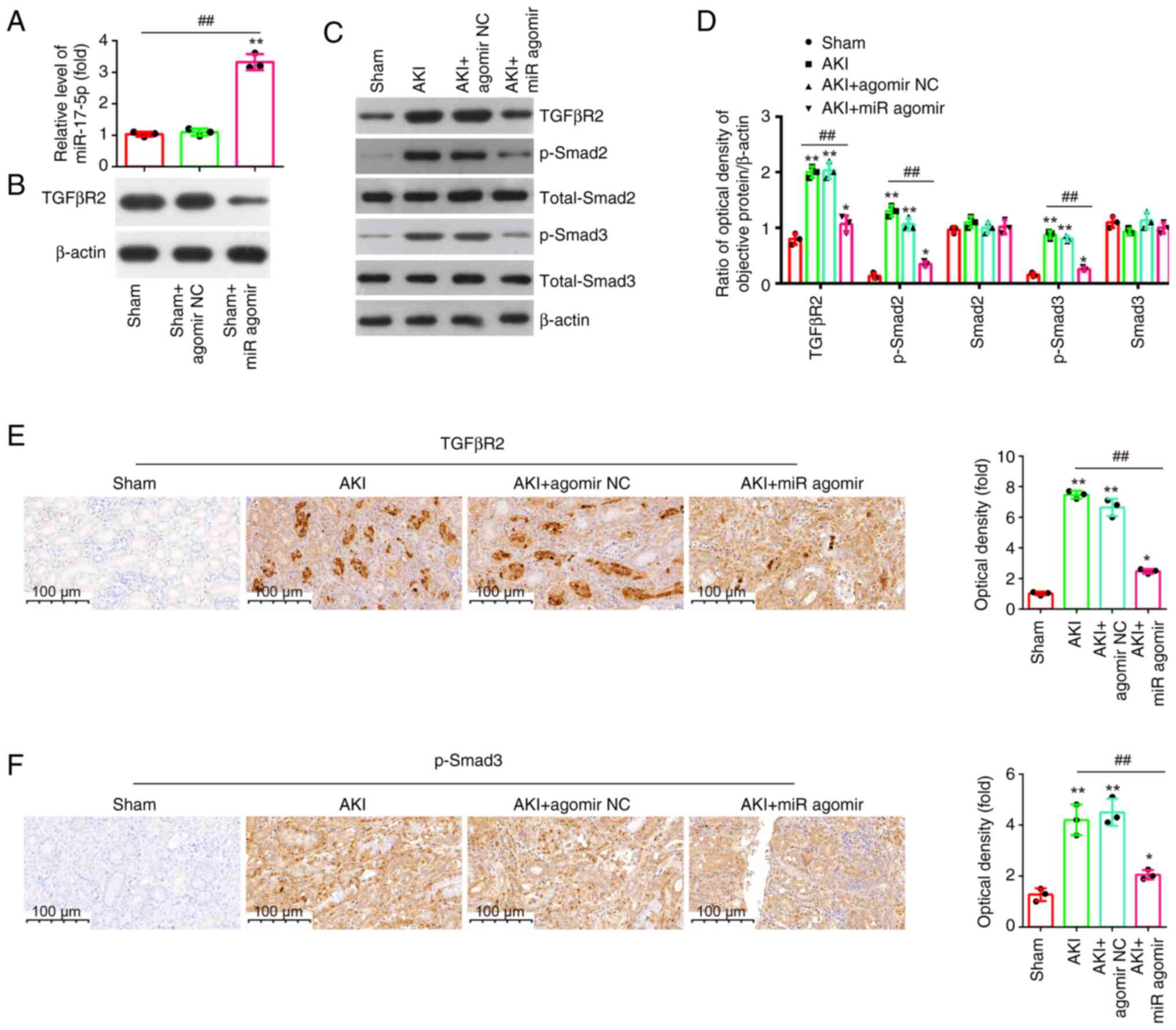|
1
|
Hoste EA, Bagshaw SM, Bellomo R, Cely CM,
Colman R, Cruz DN, Edipidis K, Forni LG, Gomersall CD, Govil D, et
al: Epidemiology of acute kidney injury in critically ill patients:
The multinational AKI-EPI study. Intensive Care Med. 41:1411–1423.
2015. View Article : Google Scholar : PubMed/NCBI
|
|
2
|
Poston JT and Koyner JL: Sepsis associated
acute kidney injury. BMJ. 364:k48912019. View Article : Google Scholar : PubMed/NCBI
|
|
3
|
Uchino S, Kellum JA, Bellomo R, Doig GS,
Morimatsu H, Morgera S, Schetz M, Tan I, Bouman C, Macedo E, et al:
Acute renal failure in critically ill patients: A multinational,
multicenter study. JAMA. 294:813–818. 2005. View Article : Google Scholar : PubMed/NCBI
|
|
4
|
Jia Y, Li Z, Feng Y, Cui R, Dong Y, Zhang
X, Xiang X, Qu K, Liu C and Zhang J: Methane-rich saline
ameliorates sepsis-induced acute kidney injury through
anti-inflammation, antioxidative, and antiapoptosis effects by
regulating endoplasmic reticulum stress. Oxid Med Cell Longev.
2018:47568462018. View Article : Google Scholar : PubMed/NCBI
|
|
5
|
Gameiro J, Carreiro C, Fonseca JA, Pereira
M, Jorge S, Gouveia J and Lopes JA: Acute kidney disease and
long-term outcomes in critically ill acute kidney injury patients
with sepsis: a cohort analysis. Clin Kidney J. 14:1379–1387. 2020.
View Article : Google Scholar : PubMed/NCBI
|
|
6
|
Kalantari K and Rosner MH: Recent advances
in the pharmacological management of sepsis-associated acute kidney
injury. Expert Rev Clin Pharmacol. 14:1401–1411. 2021. View Article : Google Scholar : PubMed/NCBI
|
|
7
|
Li Y, Suo L, Fu Z, Li G and Zhang J:
Pivotal role of endothelial cell autophagy in sepsis. Life Sci.
276:1194132021. View Article : Google Scholar : PubMed/NCBI
|
|
8
|
Lerolle N, Nochy D, Guérot E, Bruneval P,
Fagon JY, Diehl JL and Hill G: Histopathology of septic shock
induced acute kidney injury: Apoptosis and leukocytic infiltration.
Intensive Care Med. 36:471–478. 2010. View Article : Google Scholar : PubMed/NCBI
|
|
9
|
Ozkok A and Edelstein CL: Pathophysiology
of cisplatin-induced acute kidney injury. Biomed Res Int.
2014:9678262014. View Article : Google Scholar : PubMed/NCBI
|
|
10
|
Zhu Y, Fu Y and Lin H: Baicalin inhibits
renal cell apoptosis and protects against acute kidney injury in
pediatric sepsis. Med Sci Monit. 22:5109–5115. 2016. View Article : Google Scholar : PubMed/NCBI
|
|
11
|
Liu J, Zhao N, Shi G and Wang H:
Geniposide ameliorated sepsis-induced acute kidney injury by
activating PPARγ. Aging (Albany NY). 12:22744–22758.
2020.PubMed/NCBI
|
|
12
|
Betel D, Wilson M, Gabow A, Marks DS and
Sander C: The microRNA.org resource: Targets and expression.
Nucleic Acids Res. 36((Database Issue)): D149–D153. 2008.PubMed/NCBI
|
|
13
|
Bartel DP: MicroRNAs: Target recognition
and regulatory functions. Cell. 136:215–233. 2009. View Article : Google Scholar : PubMed/NCBI
|
|
14
|
Ao X, Ding W, Li X, Xu Q, Chen X, Zhou X,
Wang J and Liu Y: Non-coding RNAs regulating mitochondrial function
in cardiovascular diseases. J Mol Med (Berl). 101:501–526. 2023.
View Article : Google Scholar : PubMed/NCBI
|
|
15
|
Liu Y, Ding W, Wang J, Ao X and Xue J:
Non-coding RNA-mediated modulation of ferroptosis in cardiovascular
diseases. Biomed Pharmacother. 164:1149932023. View Article : Google Scholar : PubMed/NCBI
|
|
16
|
Du J, Cao X, Zou L, Chen Y, Guo J, Chen Z,
Hu S and Zheng Z: MicroRNA-21 and risk of severe acute kidney
injury and poor outcomes after adult cardiac surgery. PLoS One.
8:e633902013. View Article : Google Scholar : PubMed/NCBI
|
|
17
|
Zou YF, Wen D, Zhao Q, Shen PY, Shi H,
Zhao Q, Chen YX and Zhang W: Urinary MicroRNA-30c-5p and
MicroRNA-192-5p as potential biomarkers of
ischemia-reperfusion-induced kidney injury. Exp Biol Med (Maywood).
242:657–667. 2017. View Article : Google Scholar : PubMed/NCBI
|
|
18
|
Saikumar J, Hoffmann D, Kim TM, Gonzalez
VR, Zhang Q, Goering PL, Brown RP, Bijol V, Park PJ, Waikar SS and
Vaidya VS: Expression, circulation, and excretion profile of
microRNA-21, −155, and −18a following acute kidney injury. Toxicol
Sci. 129:256–267. 2012. View Article : Google Scholar : PubMed/NCBI
|
|
19
|
Zhan Y, Zhu M, Liu S, Lu J, Ni Z, Cai H
and Zhang W: MicroRNA-93 inhibits the apoptosis and inflammatory
response of tubular epithelial cells via the PTEN/AKT/mTOR pathway
in acute kidney injury. Mol Med Rep. 24:6662021. View Article : Google Scholar : PubMed/NCBI
|
|
20
|
Zhang XB, Chen X, Li DJ, Qi GN, Dai YQ, Gu
J, Chen MQ, Hu S, Liu ZY and Yang ZM: Inhibition of miR-155
ameliorates acute kidney injury by apoptosis involving the
regulation on TCF4/Wnt/β-catenin pathway. Nephron. 143:135–147.
2019. View Article : Google Scholar : PubMed/NCBI
|
|
21
|
Zhang W and Shu L: Upregulation of miR-21
by ghrelin ameliorates ischemia/reperfusion-induced acute kidney
injury by inhibiting inflammation and cell apoptosis. DNA Cell
Biol. 35:417–425. 2016. View Article : Google Scholar : PubMed/NCBI
|
|
22
|
Miao S, Lv C, Liu Y, Zhao J, Li T, Wang C,
Xu Y, Wang X, Xiao X and Zhang H: Pharmacologic blockade of 15-PGDH
protects against acute renal injury induced by LPS in mice. Front
Physiol. 11:1382020. View Article : Google Scholar : PubMed/NCBI
|
|
23
|
Zhu Y, Wei SW, Ding A, Zhu WP, Mai MF, Cui
TX, Yang H and Zhang H: The long noncoding RNA ANRIL promotes cell
apoptosis in lipopolysaccharide-induced acute kidney injury
mediated by the TLR4/nuclear factor-kappa B pathway. Kidney Blood
Press Res. 45:209–221. 2020. View Article : Google Scholar : PubMed/NCBI
|
|
24
|
Tang C, Han H, Yan M, Zhu S, Liu J, Liu Z,
He L, Tan J, Liu Y, Liu H, et al: PINK1-PRKN/PARK2 pathway of
mitophagy is activated to protect against renal
ischemia-reperfusion injury. Autophagy. 14:880–897. 2018.
View Article : Google Scholar : PubMed/NCBI
|
|
25
|
Ritchie ME, Phipson B, Wu D, Hu Y, Law CW,
Shi W and Smyth GK: limma powers differential expression analyses
for RNA-sequencing and microarray studies. Nucleic Acids Res.
43:e472015. View Article : Google Scholar : PubMed/NCBI
|
|
26
|
Livak KJ and Schmittgen TD: Analysis of
relative gene expression data using real-time quantitative PCR and
the 2(−Delta Delta C(T)) method. Methods. 25:402–408. 2001.
View Article : Google Scholar : PubMed/NCBI
|
|
27
|
Shi J, Bei Y, Kong X, Liu X, Lei Z, Xu T,
Wang H, Xuan Q, Chen P, Xu J, et al: miR-17-3p contributes to
exercise-induced cardiac growth and protects against myocardial
ischemia-reperfusion injury. Theranostics. 7:664–676. 2017.
View Article : Google Scholar : PubMed/NCBI
|
|
28
|
Yue XH, Guo L, Wang ZY and Jia TH:
Inhibition of miR-17-5p promotes mesenchymal stem cells to repair
spinal cord injury. Eur Rev Med Pharmacol Sci. 23:3899–3907.
2019.PubMed/NCBI
|
|
29
|
Hao J, Wei Q, Mei S, Li L, Su Y, Mei C and
Dong Z: Induction of microRNA-17-5p by p53 protects against renal
ischemia-reperfusion injury by targeting death receptor 6. Kidney
Int. 91:106–118. 2017. View Article : Google Scholar : PubMed/NCBI
|
|
30
|
Yuan W, Xiong X, Du J, Fan Q, Wang R and
Zhang X: LncRNA PVT1 accelerates LPS-induced septic acute kidney
injury through targeting miR-17-5p and regulating NF-κB pathway.
Int Urol Nephrol. 53:2409–2419. 2021. View Article : Google Scholar : PubMed/NCBI
|
|
31
|
Schrezenmeier EV, Barasch J, Budde K,
Westhoff T and Schmidt-Ott KM: Biomarkers in acute kidney
injury-pathophysiological basis and clinical performance. Acta
Physiol (Oxf). 219:554–572. 2017. View Article : Google Scholar : PubMed/NCBI
|
|
32
|
Han WK, Bailly V, Abichandani R, Thadhani
R and Bonventre JV: Kidney injury molecule-1 (KIM-1): A novel
biomarker for human renal proximal tubule injury. Kidney Int.
62:237–244. 2002. View Article : Google Scholar : PubMed/NCBI
|
|
33
|
Kang K, Gao Y, Wang SC, Liu HT, Kong WL,
Zhang X, Huang R, Qi ZD, Zheng JB, Qu JD, et al: Dexmedetomidine
protects against lipopolysaccharide-induced sepsis-associated acute
kidney injury via an α7 nAChR-dependent pathway. Biomed
Pharmacother. 106:210–216. 2018. View Article : Google Scholar : PubMed/NCBI
|
|
34
|
Goumans MJ, Valdimarsdottir G, Itoh S,
Rosendahl A, Sideras P and ten Dijke P: Balancing the activation
state of the endothelium via two distinct TGF-beta type I
receptors. EMBO J. 21:1743–1753. 2002. View Article : Google Scholar : PubMed/NCBI
|
|
35
|
Shang J, Sun S, Zhang L, Hao F and Zhang
D: miR-211 alleviates ischaemia/reperfusion-induced kidney injury
by targeting TGFβR2/TGF-β/SMAD3 pathway. Bioengineered. 11:547–557.
2020. View Article : Google Scholar : PubMed/NCBI
|
|
36
|
Erbüyün K, Tok D, Vatansever S, Ok G,
Türköz E, Aydede H, Erhan Y and Tekin I: Levosimendan up-regulates
transforming growth factor-beta and smad signaling in the aorta in
the early stage of sepsis. Ulus Travma Acil Cerrahi Derg.
16:293–299. 2010.PubMed/NCBI
|
|
37
|
Cheng Q and Wang L: LncRNA XIST serves as
a ceRNA to regulate the expression of ASF1A, BRWD1M, and PFKFB2 in
kidney transplant acute kidney injury via sponging hsa-miR-212-3p
and hsa-miR-122-5p. Cell Cycle. 19:290–299. 2020. View Article : Google Scholar : PubMed/NCBI
|
|
38
|
Wang J, Song J, Li Y, Shao J, Xie Z and
Sun K: Down-regulation of LncRNA CRNDE aggravates kidney injury via
increasing MiR-181a-5p in sepsis. Int Immunopharmacol.
79:1059332020. View Article : Google Scholar : PubMed/NCBI
|
|
39
|
Wei W, Yao YY, Bi HY, Zhai Z and Gao Y:
miR-21 protects against lipopolysaccharide-stimulated acute kidney
injury and apoptosis by targeting CDK6. Ann Transl Med. 8:3032020.
View Article : Google Scholar : PubMed/NCBI
|
|
40
|
Qin Y, Wang G and Peng Z: MicroRNA-191-5p
diminished sepsis-induced acute kidney injury through targeting
oxidative stress responsive 1 in rat models. Biosci Rep.
39:BSR201905482019. View Article : Google Scholar : PubMed/NCBI
|
|
41
|
Gamdzyk M, Doycheva DM, Kang R, Tang H,
Travis ZD, Tang J and Zhang JH: GW0742 activates miR-17-5p and
inhibits TXNIP/NLRP3-mediated inflammation after hypoxic-ischaemic
injury in rats and in PC12 cells. J Cell Mol Med. 24:12318–12330.
2020. View Article : Google Scholar : PubMed/NCBI
|
|
42
|
Zhao L, Jiang S, Wu N, Shi E, Yang L and
Li Q: MiR-17-5p-mediated endoplasmic reticulum stress promotes
acute myocardial ischemia injury through targeting Tsg101. Cell
Stress Chaperones. 26:77–90. 2021. View Article : Google Scholar : PubMed/NCBI
|
|
43
|
Wei Q, Sun H, Song S, Liu Y, Liu P,
Livingston MJ, Wang J, Liang M, Mi QS, Huo Y, et al: MicroRNA-668
represses MTP18 to preserve mitochondrial dynamics in ischemic
acute kidney injury. J Clin Invest. 128:5448–5464. 2018. View Article : Google Scholar : PubMed/NCBI
|
|
44
|
Song N, Zhang T, Xu X, Lu Z, Yu X, Fang Y,
Hu J, Jia P, Teng J and Ding X: miR-21 protects against
ischemia/reperfusion-induced acute kidney injury by preventing
epithelial cell apoptosis and inhibiting dendritic cell maturation.
Front Physiol. 9:7902018. View Article : Google Scholar : PubMed/NCBI
|
|
45
|
Yan Y, Ma Z, Zhu J, Zeng M, Liu H and Dong
Z: miR-214 represses mitofusin-2 to promote renal tubular apoptosis
in ischemic acute kidney injury. Am J Physiol Renal Physiol.
318:F878–F887. 2020. View Article : Google Scholar : PubMed/NCBI
|
|
46
|
Zhang YR, Wu YF, Wang H, Lin XM and Zhang
XM: Role of microRNA-17-5p in the pathogenesis of pediatric
nephrotic syndrome and related mechanisms. Zhongguo Dang Dai Er Ke
Za Zhi. 22:958–963. 2020.(In Chinese). PubMed/NCBI
|
|
47
|
Guo R, Wang Y, Minto AW, Quigg RJ and
Cunningham PN: Acute renal failure in endotoxemia is dependent on
caspase activation. J Am Soc Nephrol. 15:3093–3102. 2004.
View Article : Google Scholar : PubMed/NCBI
|
|
48
|
Zhang S, Ma J, Sheng L, Zhang D, Chen X,
Yang J and Wang D: Total coumarins from hydrangea paniculata show
renal protective effects in lipopolysaccharide-induced acute kidney
injury via anti-inflammatory and antioxidant activities. Front
Pharmacol. 8:8722017. View Article : Google Scholar : PubMed/NCBI
|
|
49
|
Huang Y, Zhou LS, Yan L, Ren J, Zhou DX
and Li SS: Alpinetin inhibits lipopolysaccharide-induced acute
kidney injury in mice. Int Immunopharmacol. 28:1003–1008. 2015.
View Article : Google Scholar : PubMed/NCBI
|
|
50
|
Weinstein M, Yang X and Deng C: Functions
of mammalian Smad genes as revealed by targeted gene disruption in
mice. Cytokine Growth Factor Rev. 11:49–58. 2000. View Article : Google Scholar : PubMed/NCBI
|
|
51
|
Chen G, Deng C and Li YP: TGF-β and BMP
signaling in osteoblast differentiation and bone formation. Int J
Biol Sci. 8:272–288. 2012. View Article : Google Scholar : PubMed/NCBI
|
|
52
|
Sun J, Ge X, Wang Y, Niu L, Tang L and Pan
S: USF2 knockdown downregulates THBS1 to inhibit the TGF-β
signaling pathway and reduce pyroptosis in sepsis-induced acute
kidney injury. Pharmacol Res. 176:1059622022. View Article : Google Scholar : PubMed/NCBI
|



